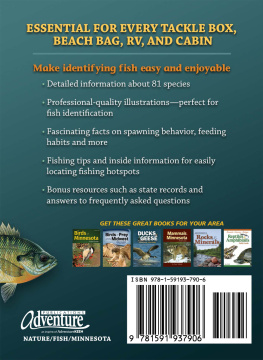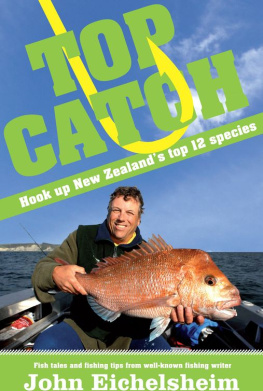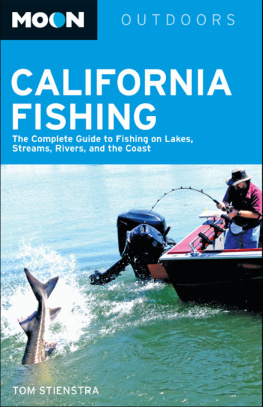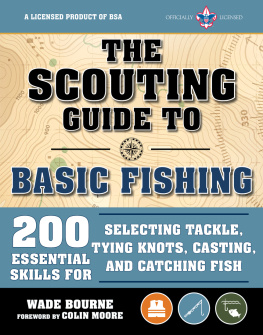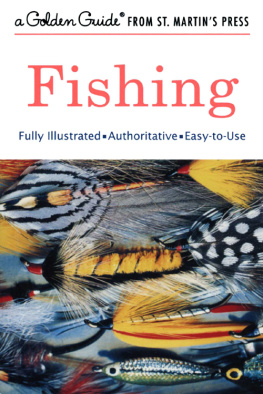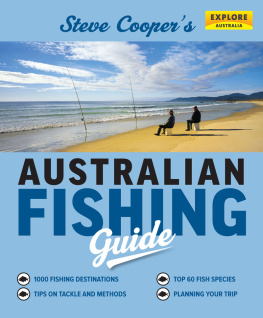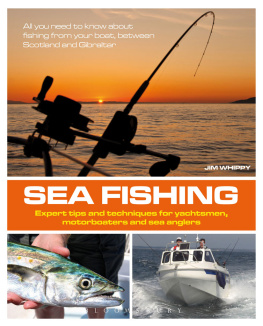

ACKNOWLEDGMENTS
Special thanks to Dave Bierman from the Iowa Department of Natural Resources for reviewing this book. Thanks also to the United States Fish and Wildlife Service and the Minnesota Department of Natural Resources.
Edited by Brett Ortler
Cover and book design by Jonathan Norberg
Illustration credits by artist and page number:
Cover Illustrations: Channel Catfish (main) and Bluegill (upper front and back cover) by Duane Raver/USFWS
Timothy Knepp/USFWS: ;
Joseph Tomelleri: .
10 9 8 7 6 5 4 3 2 1
Fish of Minnesota Field Guide
First Edition 2007
Second Edition 2019
Copyright 2007 and 2019 by David Bosanko
Published by Adventure Publications
An imprint of AdventureKEEN
330 Garfield Street South
Cambridge, Minnesota 55008
(800) 678-7006
www.adventurepublications.net
All rights reserved
Printed in China
ISBN 978-1-59193-790-6 (pbk.); ISBN 978-1-59193-791-3 (ebook)
TABLE OF CONTENTS
WHATS NEW IN THE SECOND EDITION
First released in 2007, Fish of Minnesota has made fish identification easy for more than a decade. Now including 81 species, this revised and expanded second edition offers even more. Heres whats new in the second edition:
More Species: Six additional fish species are included in this book; several are aquatic invasive species, so its especially important to be on the lookout for them. The new additions are the Silver Carp, the Bighead Carp, the White Perch, the Blue Catfish, the Round Goby, and the Ruffe.
Fishing Tips: Popular game species now feature fishing tips to help you land that lunker.
Revised and Updated: Whether its a new state fishing record, the advance of invasive species, or updated range information, each account has been carefully reviewed and updated to reflect the latest developments in the angling world and fisheries science.
The Same Stuff You Know and Love: As always, the book features world-class illustrations, fascinating facts about each species range, natural history, and more.
HOW TO USE THIS BOOK
The fish are organized by family, such as Catfish (Ictaluridae), Perch (Percidae) and Sunfish (Centrarchidae). Each family is then listed in alphabetical order. Within these families, individual species are arranged alphabetically by common name in their appropriate groups. For example, members of the Sunfish family are divided into the Black Bass, Crappie, and True Sunfish groups. For a detailed list of fish families and individual species, turn to the ; the Index (pg. 172) provides a reference guide to fish by common name (such as Mooneye) and other common terms for the species.
Fish Identification
Determining a fishs body shape is the first step to identifying it. Each fish family usually exhibits one or sometimes two basic outlines. Catfish have long, stout bodies with flattened heads; barbels or whiskers around the mouth; a relatively tall, but narrow, dorsal fin; and an adipose fin. There are two forms of Sunfish: the flat, round, plate-like outline we see in Bluegills, and the torpedo or fusiform shape of Largemouth Bass.
In this field guide, you can quickly identify a fish by first matching its general body shape to one of the fish family silhouettes listed in the are provided to explain how the information is presented in each two-page spread.
For some species, the illustration will be enough to identify your catch, but it is important to note that your fish may not look exactly like the artwork. Fish frequently change colors. Males that are brightly colored during the spawning season may show muted coloration at other times. Likewise, bass caught in muddy streams show much less pattern than those taken from clear lakesand all fish lose some of their markings and color when removed from the water.
Most fish are similar in appearance to one or more other speciesoften, but not always, within the same family. For example, the Walleye is remarkably similar to the Sauger. To accurately identify such look-alikes, check the inset illustrations and accompanying notes below the main illustration, under the Similar Species heading.
Throughout Fish of Minnesota we use basic biological and fisheries management terms that refer to physical characteristics or conditions of fish and their environment, such as dorsal fin or turbid water. For your convenience, these are listed and defined in the .
Understanding such terminology will help you make sense of reports on state and federal research, fish population surveys, lake assessments, management plans, and other important fisheries documents.
FISH ANATOMY
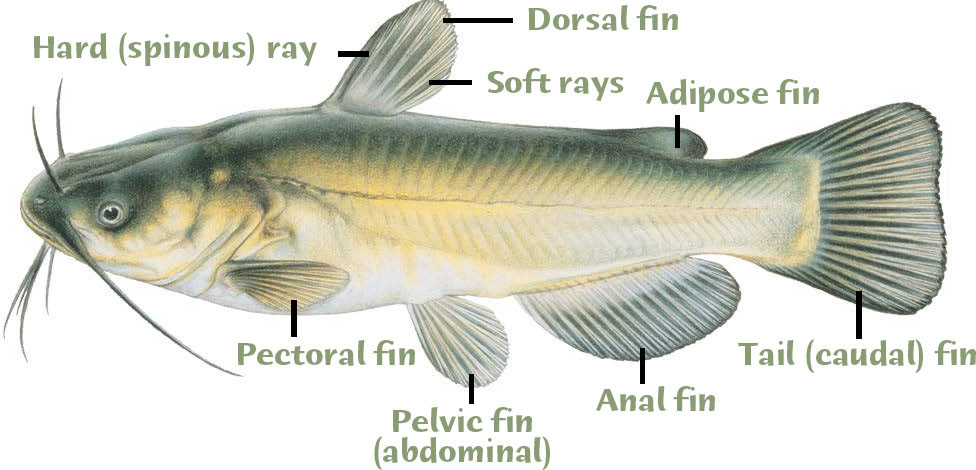
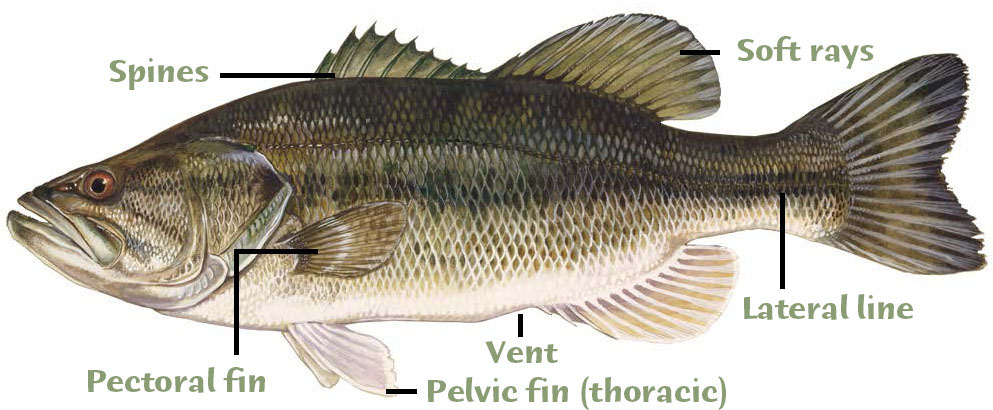
To identify fish, you will need to know a few basic terms that apply to fins and their locations.
Fins are made up of bony structures that support a membrane. There are three kinds of bony structures in fins. Soft rays are flexible fin supports that are sometimes branched. Spines are stiff, often sharp, supports that are not jointed. Hard rays are stiff, pointed, barbed structures that can be raised or lowered. Catfish are famous for their hard rays, which are mistakenly called spines. Sunfish have soft rays associated with spines to form a dorsal fin.
Fins are named by their position on the fish. The dorsal fin is on the top along the midline. A few fish have another fin on their back called an adipose fin. This is a small, fleshy protuberance located between the dorsal fin and the tail and is distinctive of trout and catfish.
On each side of the fish near the gills are the pectoral fins. The anal fin is located along the midline on the fishs bottom or ventral side. There is also a paired set of fins on the bottom of the fish called the pelvic fins. Pelvic fins can be in the thoracic position just below the pectoral fins or farther back on the stomach in the abdominal position. The tail is known as the caudal fin.
EyesIn general, fish have good eyesight. They can see color, but the light level they require to see well varies by species. For example, Walleyes see well in low light, whereas Bluegills have excellent daytime vision but see poorly at night, making them vulnerable to predation. Catfish have poor vision both night and day.
NostrilsA pair of nostrils, or nares, is used to detect odors in the water. Eels and catfish have particularly well-developed senses of smell.
MouthThe shape of the mouth is a clue to what the fish eats. The larger the food it consumes, the larger the mouth.
TeethNot all fish have teeth, but those that do have teeth use them to feed. Walleyes, northern pike, and muskies have sharp canine teeth for grabbing and holding prey. Minnows have teethlocated in the throat and used for grinding. Catfish have cardiform teeth, which feel like a rough patch in the front of the mouth. Bass have tiny patches of vomerine teeth in the roof of the mouth.
Next page
